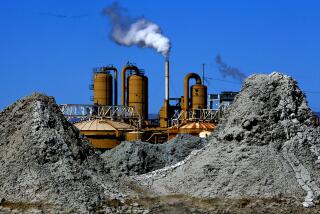CalPERS set to divest from thermal-coal companies
- Share via
The CalPERS Investment Committee will have a new task at its regular meeting Monday along with its main job of trying to boost flagging investment returns: dumping its coal holdings.
The California Public Employees’ Retirement System, the nation’s largest public pension fund, is now required by state law to sell its holdings in coal-producing companies. So too must the California State Teachers’ Retirement System, which meets Nov. 4 to 5.
Gov. Jerry Brown signed the bill into law this month. Those supporting SB 185 hailed it as an important step in the battle against climate change and for the broader idea of divestment: the use of public pension fund investment to advance social goals.
“This is a big win for our movement and demonstrates the growing strength of divestment campaigners around the world,” said May Boeve, executive director of 350.org, which pushed for the bill backed by Senate President Kevin de León (D-Los Angeles).
The law requires CalPERS and CalSTRS by June 1, 2017, to sell holdings in companies that receive at least half their revenue from so-called thermal coal, which is ground into a powder and burned in a boiler to produce steam.
The immediate financial effect of the bill on the funds is negligible. The total CalPERS fund, $293.4 billion as of last week, holds stakes in 24 thermal-coal related companies representing a mere 0.03% of the fund, or about $83 million. CalSTRS said its coal-related holdings are even smaller, about $6.7 million in 11 firms across its $184-billion fund.
Still, the symbolic effects of the law could be large. It adds coal to a list of products such as tobacco and assault weapons that have been deemed beyond the pale for public-pension investors, as have ostracized regimes such as Sudan and Iran. Backers of the bill said the divestment movement will be extended to producers of oil, gas and other fossil fuels.
“This is a great first step,” said Janet Cox, who led the effort on behalf of SB 185 for Fossil Free California, an Oakland environmental group.
Jason Hayes, associate director of the American Coal Council in Washington, said divestment would only add to the cost of electricity. The movement is pushing ahead, he said, even as the industry has invested more than $136 billion in cleaner technology and has been able to reduce emissions of key pollutants by nearly 90%.
“Similar improvements would be hailed as an environmental success story in any other industry but, for no clear reason, are ignored when it comes to coal-fueled energy,” he said, calling SB 185 “a mistake.”
Divestiture will be one of the items on the agenda when Ted Eliopoulos, CalPERS chief investment officer, testifies before the board’s investment committee Monday.
In a statement, CalPERS said it was prepared to implement the law, including a provision that requires that it “constructively engage” with thermal-coal companies to determine whether they are “transitioning their business models to adapt to clean energy generation.”
Finance experts are skeptical of the benefits of using investment policy to advance social goals.
CalPERS already is having trouble meeting its main job of fully funding its obligations to 1.7 million current and future retirees. At Monday’s meeting, the investment committee will consider a new risk mitigation strategy that would involve lowering its target return of 7.5%, with the potential to further shift funding obligation to taxpayers.
CalPERS itself, in a blog post last year on the broader topic of combating climate change, said divestment “is not the solution.”
“Our view is that the solution lies in tackling energy companies through an engagement process focused on finding solutions, rather than walking away,” it said.
Steven N. Kaplan, a finance professor at the University of Chicago, said that divestment invariably requires a trade-off.
“Any time you mix social goals, there is a cost,” he said. “The question is simply how big that cost is. Some would argue it is small; others that if you stay out of a large asset class, it will ultimately be meaningful.”
A 2007 paper by economists from Princeton and the University of British Columbia found that so-called sin stocks — companies involved in gambling, tobacco and alcohol — had “higher expected returns than otherwise comparable stocks,” despite being held by fewer “norm-constrained” institutions such as pension funds.
Though a 1992 amendment to the state constitution, the California Pension Protection Act, sought to eliminate political interference in pension fund investing, the act did leave the Legislature free “to continue to prohibit certain investments by a retirement board where it is in the public interest to do so.”
An analysis of CalPERS’ divestments over the years, including from Apartheid-era South Africa, found that they have cost the fund $3.8 billion to $8.3 billion.
The analysis by CalPERS’ main consultant, Wilshire Associates, said its findings “generally confirm” what has become a standard academic argument that “limiting the opportunity set for investments has a deleterious impact on performance over long periods of time.”
Right now might not be the best time to sell energy stocks. The sector is still down more than 13% for the year through Friday, even after recovering about 13% this month, according to FactSet Research Systems Inc.
Pro-divestment advocates said that the bigger risk is staying in environmentally damaging investments that will ultimately be subject to government action as climate perils become apparent.
Said Cox of Fossil Free California: “The fact is, these stocks are not going to be around forever.”
More to Read
Inside the business of entertainment
The Wide Shot brings you news, analysis and insights on everything from streaming wars to production — and what it all means for the future.
You may occasionally receive promotional content from the Los Angeles Times.











